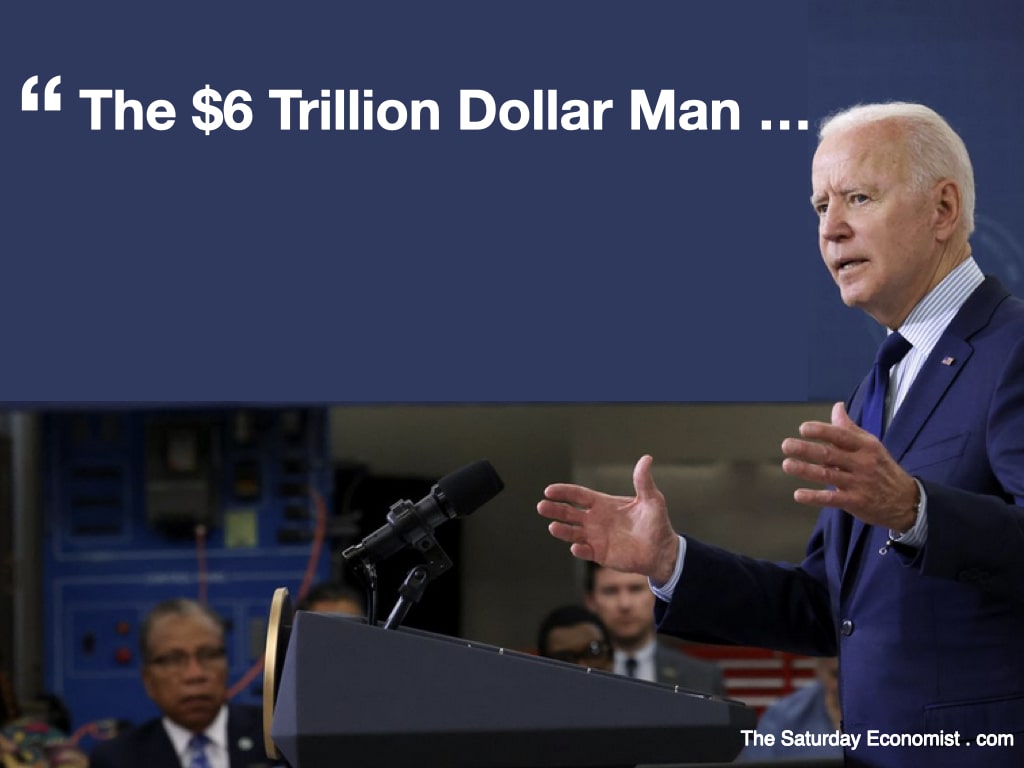|
Where does the money come from ...
Focus on the U.S. This week. Joe Biden announced his £6 trillion dollar budget. The President is committed to an expansion of support for infrastructure, education and the social safety net. Questions are asked, "Where does the money come from?" "Do budget deficits matter any more?" "What will happen to inflation?" Is there a risk of hyperinflation" "Will Interest rates have to rise?" The President's budget forecasts a $1.8 trillion deficit in the fiscal year 2022, followed by a $1.3 trillion deficit in subsequent years. This follows a $3.7 trillion deficit in fiscal 2021. The good news, the deficit is falling as a percentage of GDP from 17% this year to 8% next, then falling further in subsequent years. $10 trillion dollars will have been added to the U.S. debt pile over a period of five years. Where does the money come from? The Fed has been ready to step in as the buyer of last resort. Modern Monetary Financing of the fiscal deficit ensures the Fed will continue to mop up new issuance, at the rate of $120 billion per month. The Fed balance sheet has expanded from $4.2 trillion at the beginning of January last year, to $7.4 trillion by the end of December 2021. A $10 trillion dollar balance sheet is within reach in 2022. Where does the money come from? "We print it digitally" explains the Chairman of the Federal Reserve Jerome Powell in The Saturday Economist Live episode this month. Domestic markets are happy to accept the increase in dollar reserves and money supply. US bond yields hold steady at 1.6%. Foreign exchanges are a little more circumspect about the prospects for the Greenback. Federal debt will increase to 110% of GDP this year. It is set to rise to almost 120% by the end of the decade. Sterling continues to test the $1.42 level. Some expect the move to $1.49 by the end of the year. Growth expectations rise for the year ... Stronger growth could help.The US administration is forecasting growth of 5.2% this year and 3.2% next. The IMF is forecasting growth of 6.5% this year. The latest IHS Markit US Composite index hit 68 in April, that's a series high. Businesses reported an unprecedented expansion in activity in services and in manufacturing. US growth may well exceed 7% this year, assuming firms can secure staff and supplies to support the recovery. Prices are rising. The Bureau of Economic Analysis released the latest personal consumption inflation measure for April. It came in ahead of expectations at 3.6%. It was the strongest reading in 13 years. Not sure what the fuss is about, CPI inflation hit 4.2% in the same month. The pick up in inflation is happening as the rebound in demand meets supply shortages. Output is slow to return to pre-pandemic levels. Prices are squeezed higher. Basing effects are evident. Prices collapsed in April last year. Oil prices WTI basis traded at $16 dollars a barrel. In one week, traders were paid $35 dollars just to roll the barrels away. Inflation is always and everywhere a transitory phenomenon. The Fed is prepared to look through the short term blip in prices, avoiding "tapering" and an increase in base rates to secure first, a return to full employment. Not all are convinced. Former Treasury Secretary Lawrence Summers thinks President Biden’s budget risks overheating the U.S. economy. Summers said Biden is right to be trying to fix infrastructure and reduce inequality but he is worried by the large budget deficits. “I am worried in both the short and medium term about overheating.” The President's tax plan may ease fears on that score. Higher rate tax payers will pay part of the price, the top rate of capital gains tax will rise to 40% in the Biden plan. Either way, for prices this is not a return to high inflation of the 1970s when the collapse of the Peruvian anchovy crop led to hyper-inflation around the world. OK the quadrupling of oil prices didn't help. Today's inflation is transitory and transient. It's due to bottle necks, excessive commodity speculation and a manufacturing diet of "Chips With Everything. The best cure for rising prices is rising prices ... That's all for this week, we will be back with more next week, stay safe ... John
0 Comments
Leave a Reply. |
The Saturday EconomistAuthorJohn Ashcroft publishes the Saturday Economist. Join the mailing list for updates on the UK and World Economy. Archives
July 2024
Categories
All
|
| The Saturday Economist |
The material is based upon information which we consider to be reliable but we do not represent that it is accurate or complete and it should not be relied upon as such. We accept no liability for errors, or omissions of opinion or fact. In particular, no reliance should be placed on the comments on trends in financial markets. The presentation should not be construed as the giving of investment advice.
|
The Saturday Economist, weekly updates on the UK economy.
Sign Up Now! Stay Up To Date! | Privacy Policy | Terms and Conditions | |

 RSS Feed
RSS Feed